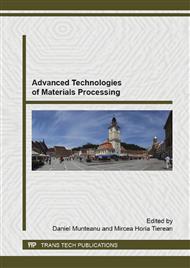p.230
p.236
p.242
p.254
p.261
p.271
p.282
p.288
p.293
Research Regarding the Development of Manufacturing of Electrical Welded Pipes from Micro-Alloy Steel with Good Weldability and Toughness
Abstract:
Obtaining welded pipes with a superior toughness and plasticity of weld seam is strictly related to the properties of steel utilized in manufacturing welded pipes and firstly to its weldability. As a consequence, experimental research has been focused on obtaining steel with a lower equivalent carbon content but presenting high toughness and plasticity properties. In order to compensate for the decreased mechanical strength of the steel caused by reducing the carbon and manganese contents, in the first stage micro-alloying has been applied with niobium (0.040-0.055 % wt. Nb) to a construction steel, with a reduced content of carbon and manganese. The results of the mechanical characteristics obtained on hot rolled coil were good, but in the cold rolling process of pipes, the toughness characteristics have decreased excessively due to severe cold working characteristics of this steel. The second stage of experimental research has utilized microalloying with titanium (0.015-0.025 % wt. Ti), simultaneously with reducing the niobium content to a maximum level of 0.030% wt. Nb. Also, in order to reduce the cold brittleness of the steel, the maximum phosphorus content has been limited to 0.010 % wt. It was obtained excellent results with respect to the material toughness (evaluated by the impact test on KV specimen), the toughness value going up from 30-40 Joules to 150-180 Joules, while maintaining the excellent results previously obtained for steel weldability as well as the overall mechanical characteristics.
Info:
Periodical:
Pages:
261-268
Citation:
Online since:
October 2015
Authors:
Price:
Сopyright:
© 2015 Trans Tech Publications Ltd. All Rights Reserved
Share:
Citation:


